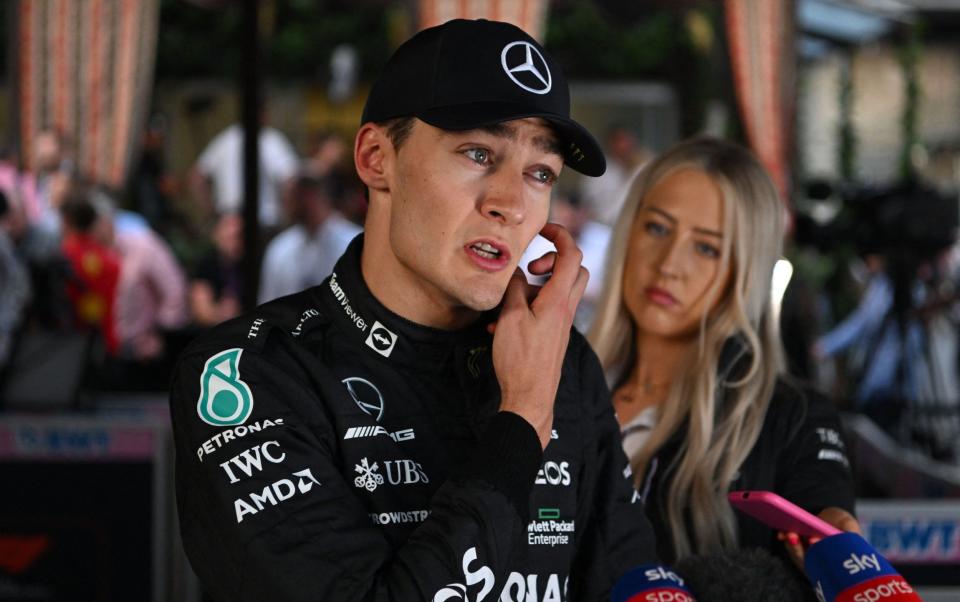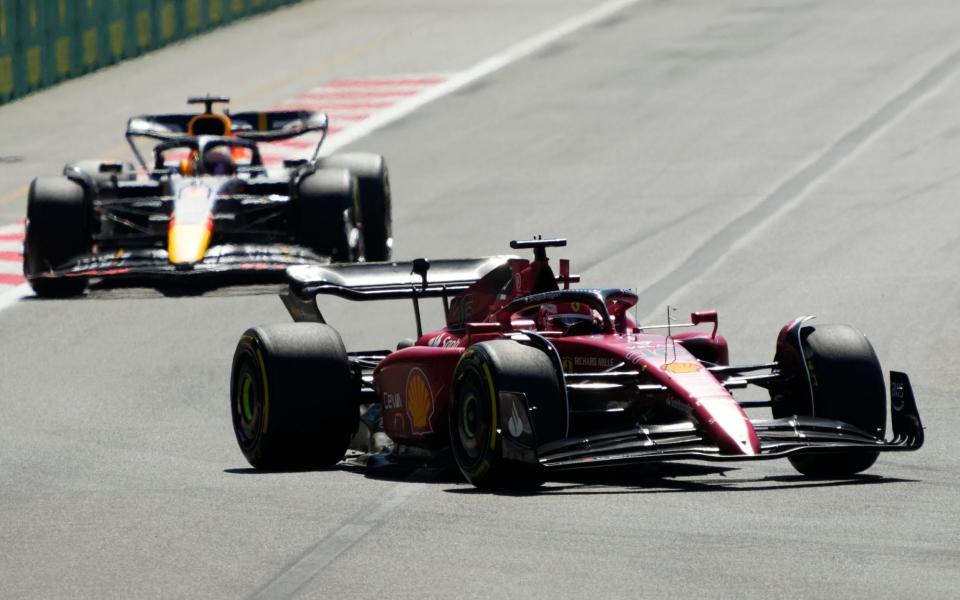Why Mercedes' car is bouncing so much and what the 6G impacts are doing to Lewis Hamilton's spine

After eight consecutive constructor titles, in 2022 Mercedes have fallen off the pace and are no longer in contention for victories. Both Lewis Hamilton and George Russell have had to hope for retirements ahead of them to snatch a spot on the podium.
And in Azerbaijan they also had to contend with, what they say, is the most uncomfortable driving experience of their lives due to persistent bouncing.
They are not the only team to suffer, but it was evident just how much Hamilton was afflicted as he struggled out of his car after the chequered flag in Baku.
Why did Mercedes suffer so badly in Baku?
Eight races in and it appears that Mercedes are not a great deal closer to (i) unlocking the potential speed in their car or (ii) reducing the bouncing enough to give their drivers a comfortable ride.
The team's specific struggles in Azerbaijan – with its long and bumpy pit straight – were due to a combination of problems, says former Jordan and Jaguar technical director Gary Anderson.
“In Monaco, where a car never really gets that low to the ground, Mercedes had major problems with their car over the bumps. This should have highlighted to them that their suspension control seems to be inadequate,” he says.
“In Azerbaijan they had the same problem, plus porpoising down the long pit straight.”
“All of the cars are suffering this issue to some extent but the Mercedes is doing it much more because of the aerodynamic concept on their car, coupled with the poor ride control.”
What is the physical effect on the drivers’ bodies?
The forces going through Hamilton’s spine have been reported as high as 6G at points in the race in Baku. His discomfort was clear to see and hear during and after the race. Other drivers like Daniel Ricciardo also complained of feeling “rattled”. Russell has spoken out on numerous occasions about fears for the long-term health of the drivers due to the “brutal” bouncing. Their concerns are backed up by opinions by medical professionals.

“Considering the anatomy of the spine and the unique position of the driver inside the cockpit, it’s easy to understand how the porpoising effect can have a huge impact on the driver’s spine,” says Dr Matteo Bartalucci, Head of Medical Services at Formula Medicine, which provides physical training programs to drivers.
“When the car bounces up and down, the cervical and dorsal spine have to cope with this additional overload and that must be supported by the intervertebral discs, which act as shock absorbers and provide stability to the spinal column.”
We are only eight races into a 22-race season, so there should also be worries for the medium-long term for some of the drivers. It could lead to something more serious later on.
“Repeated stress exerted upon the spinal discs can lead to disc degeneration which cause the central part of it (nucleus pulposus) to spill through a tear created in the weakened outer ring of the disc (annulus fibrosus), with consequent compression of the spinal cord and/or of the nerve roots,” Dr Bartalucci says.
It is also not out of the question that drivers might need to miss races later in the season, depending on the extent of the spasms and spillage.
It was noticeable that Russell did not seem to suffer them to the same degree as Hamilton. Age could be a factor in this, says Dr Bartalucci.
“Generally speaking, as for many other medical issues, the younger the better. This is not to say that Lewis Hamilton is old, but he has many more years of motorsport ‘on his shoulders’ compared to Russell.”
“Furthermore, disc degeneration is more likely to happen at older age due to disc dehydration and reduced flexibility,” he adds.
Why are Mercedes experiencing this worse than others?
Unlike Red Bull and Ferrari, Mercedes’ divergent aerodynamic concept is partly why they are suffering so badly.
The main ‘concept’ of their 2022 car is the slim side pods (so called ‘zero pods’) and this means that more of the floor is exposed. The regulation changes for this year mean that a greater percentage of downforce comes from the floor compared to previous years.
Mercedes are trying to generate more downforce from the under-floor of the car than their rivals, according to Anderson.
The potential for lap time is there if they can make it work (though they have not been able to so far) but this is exactly what is causing them to experience porpoising and bouncing worse than other teams.
“Ferrari’s and Red Bull’s designs exploit the front corner of the floor a lot more, getting more downforce from that area. That means the rear of the floor and diffuser does not have to do as much work to create downforce,” Anderson says.
“Mercedes are trying to do everything with the back of the car and nothing with the front. For these reasons, it is not as critical for Red Bull and Ferrari to get the rear of their car as close to the ground to get performance.
“The more downforce you get out of the under-floor, as Mercedes think they have, the more problems you are going to have, as Mercedes do have.
“Red Bull seem to have the best understanding of porpoising and the best compromise. That can be seen in their overall level of performance,” Anderson adds.
"Anderson describes the Mercedes floor concept as akin to a light switch. When it gets near the ground the downforce increases massively, which leads to porpoising. A change in the sidepod design of the foot on the outer edge could make it more like a ‘dimmer switch’ where the downforce builds up gradually and eliminates the extent of the issue."

What is the cure?
There are simple ways around this for Mercedes, albeit with some performance cost. The most fundamental and easy fix would be raising the ride height of the car. This would at least allow the drivers to feel more comfortable in the car and limit the damaging physical effects.
This is something, combined with running the suspension softer, that Mercedes should have tried much earlier, Anderson believes.
“You don’t have to be a brain surgeon to work out Mercedes should have done this a few races ago. Yes, it would lose them some aerodynamic performance, but motor racing is all about compromise.
“This might not be enough for them to beat Ferrari or Red Bull and it might lose them a couple of tenths. But it would give the drivers a car they can have confidence in, which is an enormous thing when compared to just finding a few points of downforce,” Anderson says.
There has been talk in the paddock of changing the regulations either this season or next to limit the long and medium term damage to drivers’ bodies.
A minimum ride height regulation change would be one way of combating the issues, but that would need to be approved by eight of the 10 teams and it is unlikely that all teams would be in favour.
Christian Horner, Red Bull team principal, does not believe that it is right to change the regulations just because some teams are suffering worse than others. That is understandable. No team wants to give up an advantage and allow their rivals the chance to close up. And nor should they.
"I think it'd be unfair if there was a rule change just because they've missed the target" ❌
Christian Horner doesn't think the F1 regulations should be amended after some teams suffered severe porpoising issues in Baku 🔽 pic.twitter.com/l37W7zZloi— Sky Sports F1 (@SkySportsF1) June 12, 2022
Anderson tends to agree but has a potential solution that would avoid a minimum ride height.
“It is not the regulations’ fault but if the FIA did step in on safety grounds they could make a simple change to the regulations. One solution would be to raise the floor at the sidepod area a certain amount, say 20mm or 30mm, to stop that rear section of the floor getting close to the ground.
“It would be like raising the ride height without raising the actual car. You would create the ‘dimmer switch’ effect in the regulations. It’s very easy for the regulations to do something but they need to be careful to do the right thing.”

 Yahoo Sport
Yahoo Sport 





































